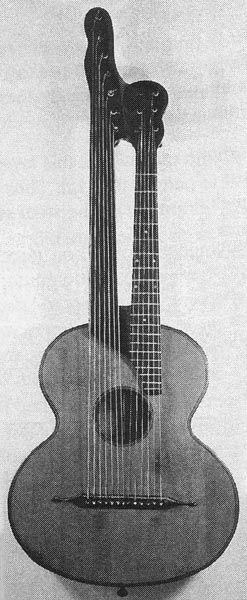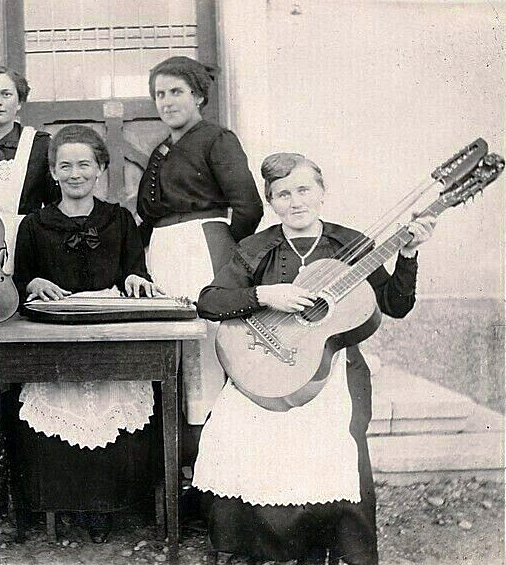We last celebrated the (mostly) American women who played those amazing Gibson harp guitars from about 1905-1925.
Now we travel to Central Europe to look at the wide variety of musical groups where women took on the role of accompaniment on their many forms of kontragitarren, i.e.: “contra guitars,” sometimes called “bass (or contrabass) guitars” and, depending on the music, “Schrammel guitars”!
(The title is my colleague Erik Hofmann’s translation of my title “Multiple Female Players of Schrammel Guitars”…whaddaya know, sometimes the German language actually shortens things!)
The exotic term comes from the brothers Schrammel (Johann and Josef), Vienna conservatory musicians who astoundingly created an entire genre of music – in their name – that has lasted to today!

They (the two violinists in the middle) formed the group in 1878 with a well-known guitarist named Anton Strohmayer. A year later, Strohmayer switched to what had by then become a ubiquitous instrument – a 13-string “bass guitar” (which would come to be known as a kontragitarre and what we today classify as a harp guitar). His was built by Viennese luthier Josef Swozil (Swosil) in 1879.
Six years later, they added the acclaimed George Danzer on G-clarinet, and Schrammelmusik was officially born! (Danzer would later be replaced by Anton Ernst on accordion; either instrument and often both, in conjunction with violins and a harp guitar would then come to define Schrammelmusik.)
The group, specifically their particular style of music, became so beloved that it remains identified with them to this day. If you’ve never heard this music, you should! (I have a couple of clips on my Kontragitarre Players page, and there are also many CDs available.)
While considered “folk music,” it is quite sophisticated and often virtuosic. It is also complicated to describe, the tunes ranging from waltzes and polkas to marches and mazurkas. This blurb I stole from the Scenic Cruise website encapsulates it nicely:
“The enduring popularity of the Schrammel Brothers Quartet is perhaps down to the group’s infusion of musical styles. Heavily influenced by the Hungarian folk genre, the Schrammel brothers pioneered a new sound in the Austrian folk tradition which blended the rhythm and sound of the Viennese dance hall with the melancholy and poignancy of working-class folk ballads – creating a distinct sound that was both rhythmic and upbeat, but infused with themes of wistful melancholia, longing, and unrequited love.”

Right: Strohmayer’s original Swosil harp guitar is preserved in the Germanisches Nationalmuseum in Nuremberg.
You might recognize that its design comes directly from the earlier Stauffer/Scherzer innovations, Swosil being a presumed pupil of the fabled Scherzer.
With the success and global fame of the quartet (they even played the 1893 Chicago World’s Fair where Hawaiian Music made its history-making first impact!), the Viennese harp guitar would become forever known as a “Schrammelgitarre”…though they would eventually revert to the more common term (in German-speaking areas) kontragitarren. (Feel free to just call them “harp guitars” as I tend to; you won’t get in trouble!) Occasionally, instruments with just 5 or 6 bass strings tuned diatonically were used, but typically, 7, 9, or 11 floating basses in chromatic tuning was the norm.
The expert on these instruments and their use is my friend and colleague Stefan Hackl in Salzburg. I’m not even going to attempt to try to describe the endless subtle instrument forms, musical styles, or the historically shuffled borders of Austria, Hungary, Bavaria, Slovenia, Moravia, Tyrol, and (insert another hundred countries and localities here). But that’s where people used these instruments to play their own variants of this music.
For that reason, this will mainly be a “photo essay,” with minimal text. The images come mostly from eBay or my own collection (or artists’ websites); virtually none have provenance regarding date or locale. Still, I’ve attempted to show these (very roughly) from oldest to most recent for a specific reason: Though I don’t yet have the complete series I hope to, I use these musicians to illustrate that in certain parts of the world – that Austrian/Tyrolean/Central European area – harp guitars never really died out. They are a sort of “living dinosaur” – with the same general instruments and music being played today just as it was a hundred years ago in an unbroken tradition! (So, at your next harp guitar gig when someone asks “Why did they die out?” you can gleefully retort “They didn’t!” After which you’ll have to spend the next full set explaining “Schrammel guitars” …)
Here we go!

Anton Suhrer on accordion expanded his Original-Schrammel-Musik group to include seven women, adding Neapolitan mandolins and other instruments. Note also the “humor” and “vocals.”

A block-headstock harp guitar joins two zithers, one an extremely early schlagzither.

The Virtuoso Familie Krausel was not unusual in having the whole family perform together. Again we see Italian mandolins and brass instruments.

A large family group with two harp guitars, one a record-breaker with 12 chromatic basses and a stupendously oversized body.
We now get into the fully costumed “acts”…

This Tyrolean “Terzett” (trio) uses the common instrumentation of violin, zither and kontragitarre.

Dressed for the Alps, in front of a scrim to gamely try to sell the illusion, Franz Pacher’s group added an upright bass, zither, brass and humor.

B. Wilhelm’s Original Gelangs-Ensemble Andreas Hofer: A longer group name, and a better backdrop…






This woman intrigues me (thanks to Bob Armstrong for the donation). Wappengitarren (heraldic shield-shaped guitars and harp guitars) were actually quite common in the genre.
I love the posed studio shots but appreciate much more seeing these musicians in situ.

Once again, violin, zither and harp guitar.





Above is a real charmer!




I love this one. I have a lot of “theorboed lute-guitar” players, mainly of the “false Swedish lute” variety. I haven’t included any of them here. This I included because it’s such a compelling shot and because the instrument looks more like a “hybrid of a hybrid” – meaning, somewhere between a harp guitar and a theorboed lute guitar.
I began noticing modern kontragitarre players while I was putting Harpguitars.net together almost twenty years ago. Then, little by little the occasional female player would turn up on the Internet. I created a dedicated page for these players in 2010. The first two may still be playing, but I couldn’t locate them.
 Scherrzitherduo Lipp
Scherrzitherduo Lipp
 Susanne Mohr
Susanne Mohr
These next three kontragitarre players appear to be still active
(some more recent photos are included here):

Eveline Mörth with Die Metropol Schrammeln


Waltraud
Rabl
with
Wiener Frauen
Schrammeln.

Marion Zib
New additions found this week:

Zither soloist Inge Reischl also uses the instrument.

Schrammelorchester includes Maria Stippich on bass, kontragitarre and vocals.
And so – Frauen – if you perform or record with these instruments, please let me know!





